2006 DODGE RAM SRT-10 battery
[x] Cancel search: batteryPage 880 of 5267

4.BATTERY CABLE OPEN
Measure the resistance of the battery cable between the battery and the intake air heater relay for both relays.
Is the resistance less than 10 Ohms?
Ye s>>
Go To 5
No>>
Replace the battery cable from the battery to the Intake Air Heater Relay.
Perform POWERTRAIN VERIFICATION TEST VER - 1 (DIESEL). (Refer to 8 - ELECTRICAL/ELEC-
TRONIC CONTROL MODULES/ENGINE CONTROL MODULE - DIAGNOSIS AND TESTING)
5.#1 INTAKE AIR HEATER RELAY
Disconnect the #1 intake air heater relay signal wire.
Connect a jumper wire from the signal terminal of the #1 intake air heater relay to battery positive.
Did the relay click when 12 volts was applied?
Ye s>>
Go To 6
No>>
Replace #1 Intake Air Heater Relay.
Perform POWERTRAIN VERIFICATION TEST VER - 1 (DIESEL). (Refer to 8 - ELECTRICAL/ELEC-
TRONIC CONTROL MODULES/ENGINE CONTROL MODULE - DIAGNOSIS AND TESTING)
6.#2 INTAKE AIR HEATER RELAY
Disconnect the #2 intake air heater relay signal wire.
Connect a jumper wire from the signal terminal of the #2 intake air heater relay to battery positive.
Did the relay click when 12 volts was applied?
Ye s>>
Refer to the INTERMITTENT CONDITIONSymptom (Diagnostic Procedure).
No>>
Replace #2 Intake Air Heater Relay.
Perform POWERTRAIN VERIFICATION TEST VER - 1 (DIESEL). (Refer to 8 - ELECTRICAL/ELEC-
TRONIC CONTROL MODULES/ENGINE CONTROL MODULE - DIAGNOSIS AND TESTING)
Page 887 of 5267
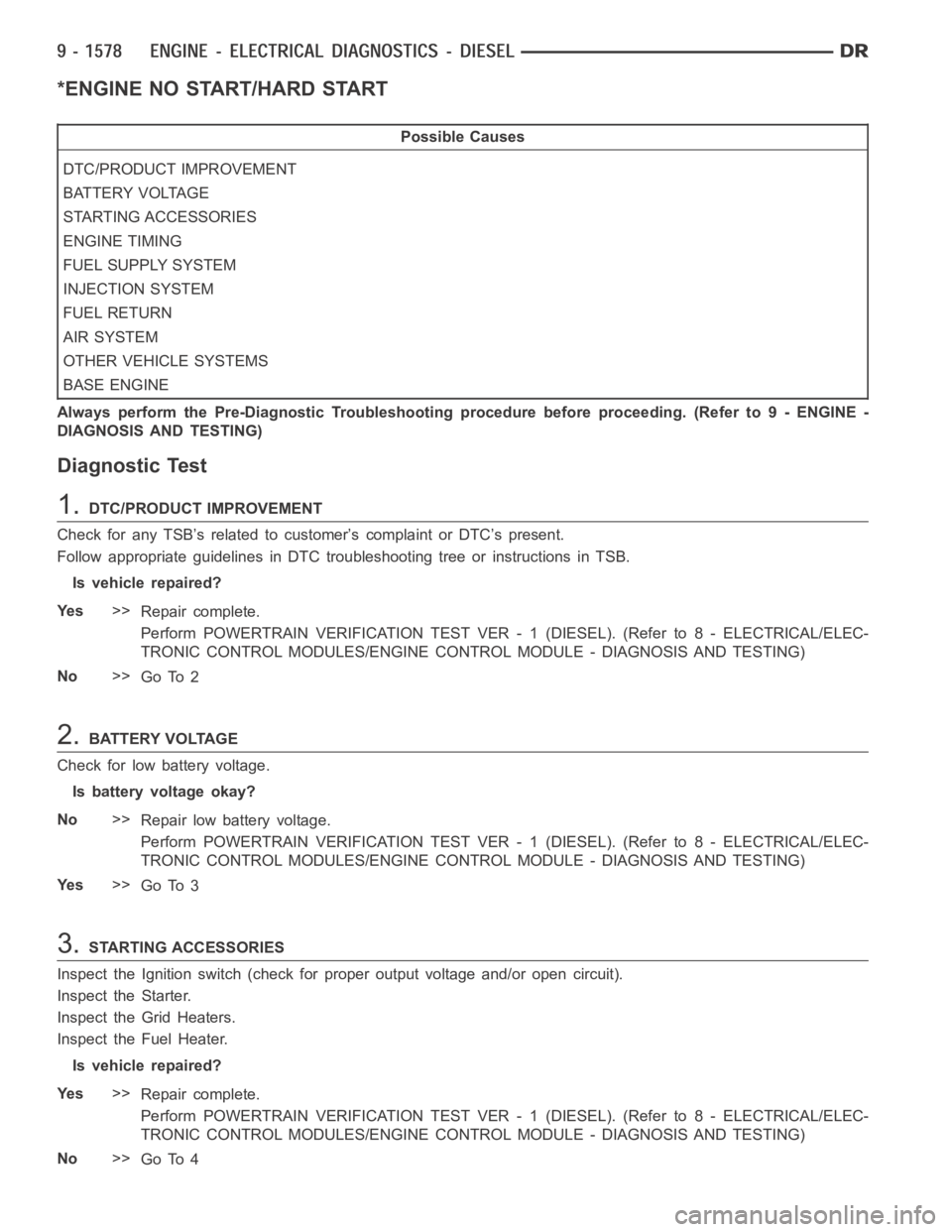
*ENGINE NO START/HARD START
Possible Causes
DTC/PRODUCT IMPROVEMENT
BATTERY VOLTAGE
STARTING ACCESSORIES
ENGINE TIMING
FUEL SUPPLY SYSTEM
INJECTION SYSTEM
FUEL RETURN
AIR SYSTEM
OTHER VEHICLE SYSTEMS
BASE ENGINE
Always perform the Pre-Diagnostic Troubleshooting procedure before proceeding. (Refer to 9 - ENGINE -
DIAGNOSIS AND TESTING)
Diagnostic Test
1.DTC/PRODUCT IMPROVEMENT
Check for any TSB’s related to customer’s complaint or DTC’s present.
Follow appropriate guidelines in DTC troubleshooting tree or instructions in TSB.
Is vehicle repaired?
Ye s>>
Repair complete.
Perform POWERTRAIN VERIFICATION TEST VER - 1 (DIESEL). (Refer to 8 - ELECTRICAL/ELEC-
TRONIC CONTROL MODULES/ENGINE CONTROL MODULE - DIAGNOSIS AND TESTING)
No>>
Go To 2
2.BATTERY VOLTAGE
Check for low battery voltage.
Is battery voltage okay?
No>>
Repair low battery voltage.
Perform POWERTRAIN VERIFICATION TEST VER - 1 (DIESEL). (Refer to 8 - ELECTRICAL/ELEC-
TRONIC CONTROL MODULES/ENGINE CONTROL MODULE - DIAGNOSIS AND TESTING)
Ye s>>
Go To 3
3.STARTING ACCESSORIES
Inspect the Ignition switch (check for proper output voltage and/or open circuit).
Inspect the Starter.
Inspect the Grid Heaters.
Inspect the Fuel Heater.
Is vehicle repaired?
Ye s>>
Repair complete.
Perform POWERTRAIN VERIFICATION TEST VER - 1 (DIESEL). (Refer to 8 - ELECTRICAL/ELEC-
TRONIC CONTROL MODULES/ENGINE CONTROL MODULE - DIAGNOSIS AND TESTING)
No>>
Go To 4
Page 892 of 5267

1.
1. Using the Scan tool, check for DTCs. Troubleshoot any active DTCs beforeperforming this test.
2. Disconnect the wiring harness from the lift pump at the fuel tank module connector and inspect the pins for
damage. Fix or replace any damaged component.
3. Connect a voltmeter between the fuel lift pump supply and return pins at the fuel tank module connector.
4. Turn the ignition to the on position. Use the Scan tool to actuate the fuellift pump, record the voltage on the
voltmeter.
5. If the voltage is greater than 11.5 volts, go to step 14. If the voltage is lessthan11.5volts,gotostep6
6. Using a voltmeter, measure the battery voltage to determine that the voltage is greater than 11.5 volts. If the
voltage is greater than 11.5 volts, go to step 7. If the voltage is not greater than 11.5 volts, troubleshoot for low
battery voltage.
7. Remove the fuel lift pump relay from the PDC. Use a voltmeter to measure the voltage at the fuel lift pump relay
voltage supply pin in the PDC. If the voltage is greater than 11.5 volts, go to step 8. If the voltage is not greater than
11.5 volts, fix or replace the harness.
8. Remove the fuel lift pump relay from the PDC. Install a spare relay in place of the fuel lift pump relay. Using the
Scan tool, actuate the fuel lift pump. Use a voltmeter to measure the voltage between the fuel lift pump supply and
return pins at the fuel tank module connector while the fuel lift pump is actuated. If the voltage is greater than 11.5
volts, replace the fuel lift pump relay. If the voltage is not greater than 11.5volts,gotostep9.
9. Disconnect the wiring harness from the fuel tank module. Remove the liftpump relay from the PDC. Using an
Ohmmeter, measure the resistance of the fuel lift pump power supply wire between the PDC relay output pin and
the fuel tank module connector. If the resistance is less than 10 ohms, go tostep 10. If it is greater than 10 ohms,
fix or replace the harness.
10. Disconnect the wiring harness from the fuel tank module. Remove the fuel lift pump relay from the PDC. Using
a voltmeter, measure the voltage between battery negative and the fuel lift pump power supply wire at the fuel
module connector. If the voltage is less than 1 volt, go to step 11. If the voltage is greater than 1 volt, fix or replace
the harness.
11. Disconnect the wiring harness from the fuel tank module. Remove the fuel lift pump relay from the PDC. Using
an ohmmeter, measure the resistance between battery negative and the fuellift pump power supply wire at the fuel
module connector. If the resistance is less than 10 ohms, fix or replace theharness. If the resistance is greater than
10 ohms, go to step 12.
12. Disconnect the wiring harness from the fuel tank module. Using an Ohmmeter, measure the resistance of the
fuel lift pump ground wire between the fuel tank module connector and battery negative. If the resistance is less
than 10 ohms, go to step 13. If the resistance is greater than 10 ohms, fix or replace the harness.
13. Disconnect the wiring harness from the fuel tank module. Using a voltmeter, measure the voltage between the
fuel lift pump ground wire and battery negative. If the voltage is less than1 volt, go to step 14. If the voltage is
greater than 1 volt, fix or replace the harness.
14. Reconnect the lift pump connector.
FLOW TEST.
1. Remove the fuel pump supply banjo fitting from the fuel injection pump.
2. Install Miller Tool #9014 fuel system test fitting into the fuel injection pump.
3. Connect one end of a section of fuel hose to the test fitting.
4. Put the other end of the fuel hose into an empty fuel container.
5. Use the scan tool to actuate the fuel lift pump.
6. While the lift pump is running, move the fuel hose from the fuel canister into a 1000ml graduated cylinder for 10
seconds.
7. Read and record the amount of fuel in the graduated cylinder after 10 seconds.
8. If you have more than 430ml in the graduated cylinder after 10 seconds, the test has successfully passed.
9. If you have less than 430ml of fuel in the graduated cylinder, inspect thefuel supply line from the fuel tank to the
fuel filter housing and the fuel supply line between the fuel filter housing and the high pressure fuel pump for signs
of damage, replace as necessary. If no damage is found, replace the fuel filter and retest.
10.Verify the Screened Banjo Bolt at the outlet of the fuel filter is free ofdebris. If debris is found, rinse screen with
water, blow dry and reinstall. Retest vehicle. If flow meets specification then trace back the source of debris, if flow
is still below spec repair damaged component.
Page 899 of 5267
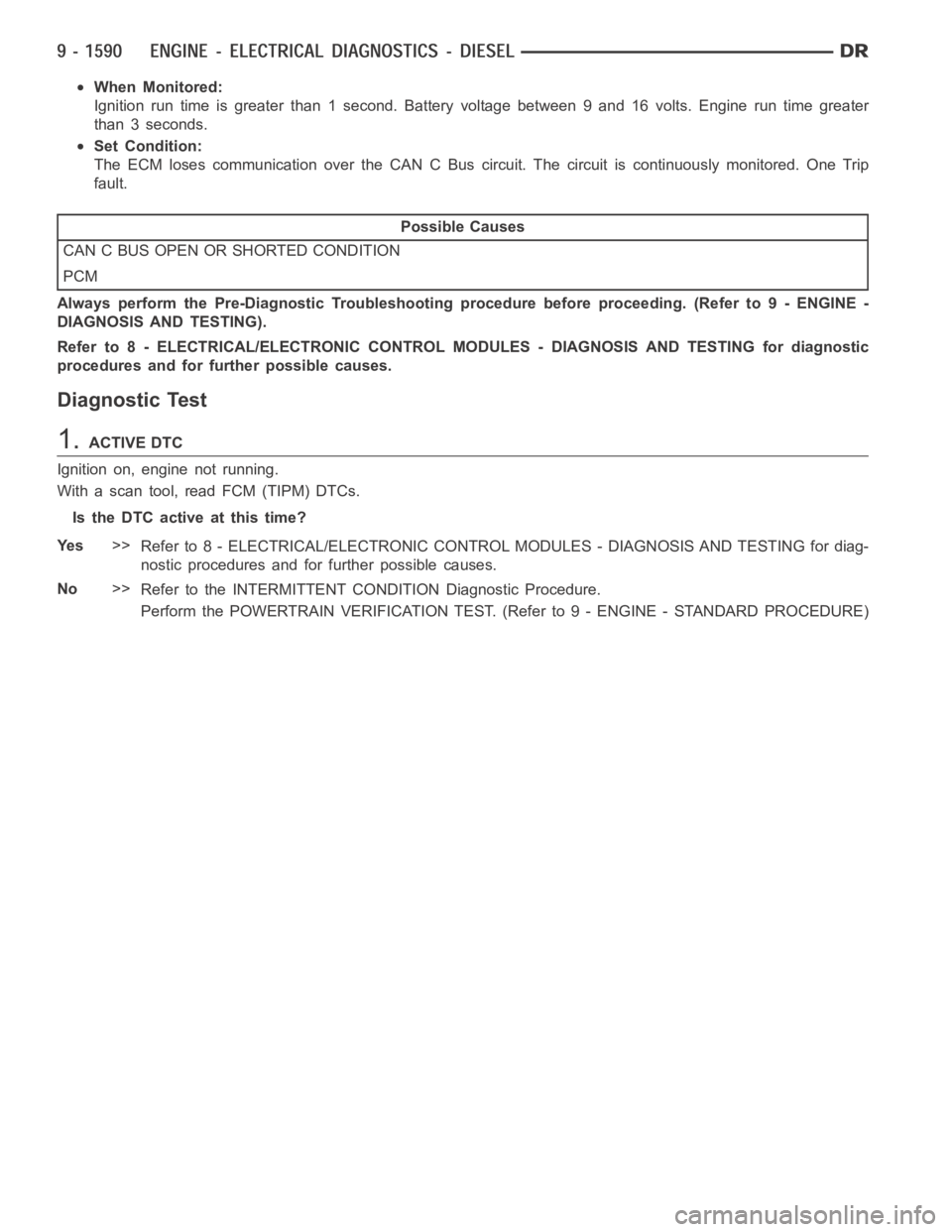
When Monitored:
Ignition run time is greater than 1 second. Battery voltage between 9 and 16volts. Engine run time greater
than 3 seconds.
Set Condition:
The ECM loses communication over the CAN C Bus circuit. The circuit is continuously monitored. One Trip
fault.
Possible Causes
CAN C BUS OPEN OR SHORTED CONDITION
PCM
Always perform the Pre-Diagnostic Troubleshooting procedure before proceeding. (Refer to 9 - ENGINE -
DIAGNOSIS AND TESTING).
Refer to 8 - ELECTRICAL/ELECTRONIC CONTROL MODULES - DIAGNOSIS AND TESTING for diagnostic
procedures and for further possible causes.
Diagnostic Test
1.ACTIVE DTC
Ignition on, engine not running.
With a scan tool, read FCM (TIPM) DTCs.
Is the DTC active at this time?
Ye s>>
Refer to 8 - ELECTRICAL/ELECTRONIC CONTROL MODULES - DIAGNOSIS AND TESTING for diag-
nostic procedures and for further possible causes.
No>>
Refer to the INTERMITTENT CONDITION Diagnostic Procedure.
Perform the POWERTRAIN VERIFICATION TEST. (Refer to 9 - ENGINE - STANDARD PROCEDURE)
Page 901 of 5267
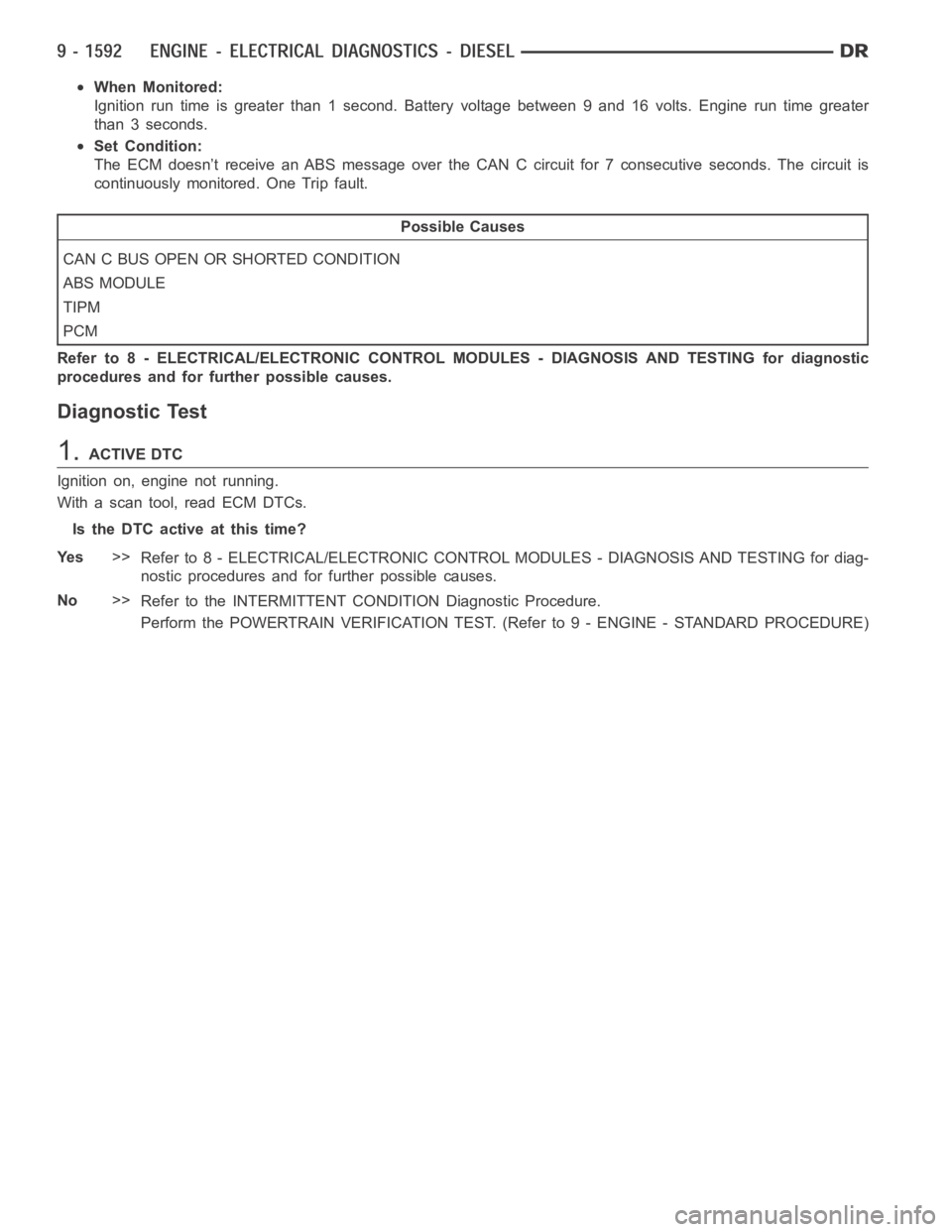
When Monitored:
Ignition run time is greater than 1 second. Battery voltage between 9 and 16volts. Engine run time greater
than 3 seconds.
Set Condition:
The ECM doesn’t receive an ABS message over the CAN C circuit for 7 consecutive seconds. The circuit is
continuously monitored. One Trip fault.
Possible Causes
CAN C BUS OPEN OR SHORTED CONDITION
ABS MODULE
TIPM
PCM
Refer to 8 - ELECTRICAL/ELECTRONIC CONTROL MODULES - DIAGNOSIS AND TESTING for diagnostic
procedures and for further possible causes.
Diagnostic Test
1.ACTIVE DTC
Ignition on, engine not running.
With a scan tool, read ECM DTCs.
Is the DTC active at this time?
Ye s>>
Refer to 8 - ELECTRICAL/ELECTRONIC CONTROL MODULES - DIAGNOSIS AND TESTING for diag-
nostic procedures and for further possible causes.
No>>
Refer to the INTERMITTENT CONDITION Diagnostic Procedure.
Perform the POWERTRAIN VERIFICATION TEST. (Refer to 9 - ENGINE - STANDARD PROCEDURE)
Page 903 of 5267
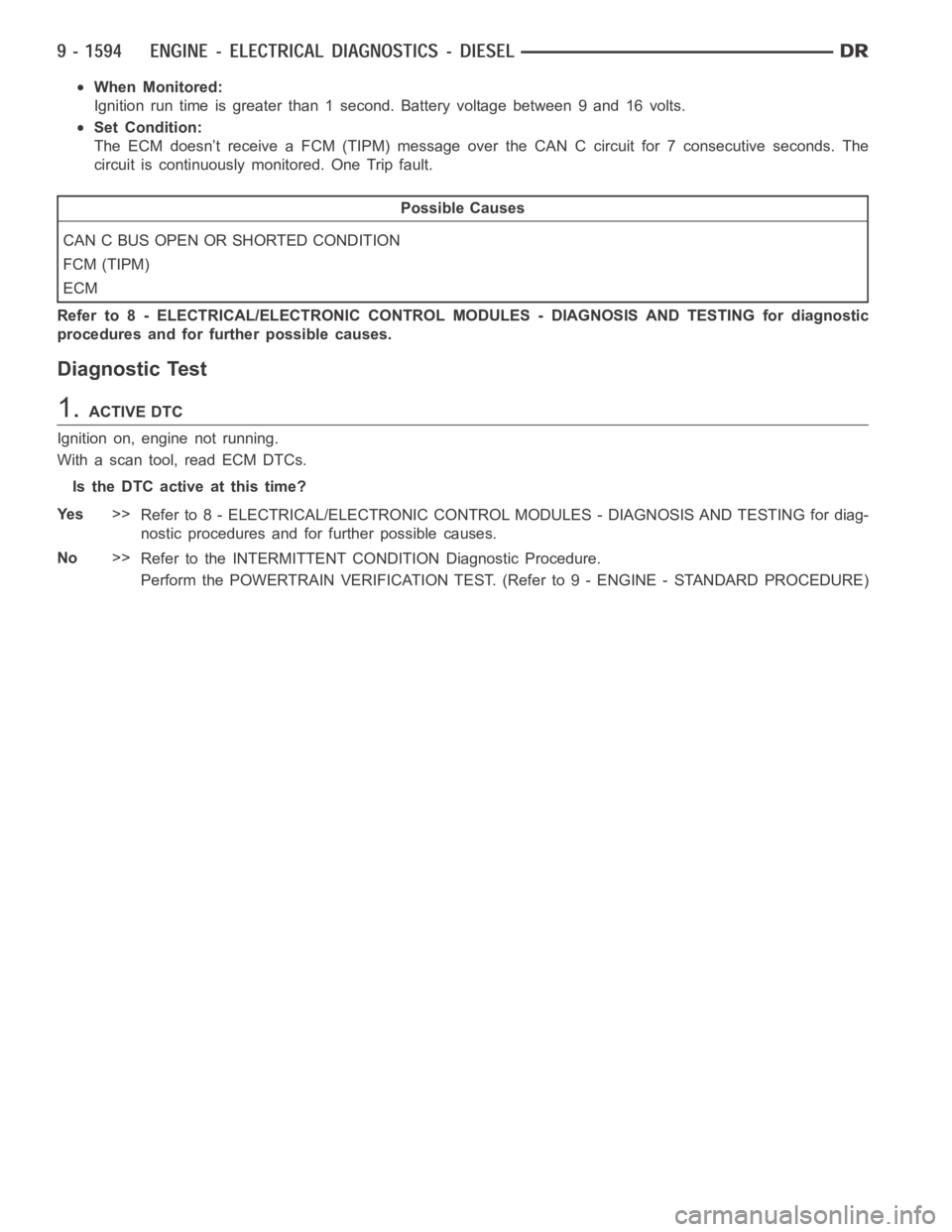
When Monitored:
Ignition run time is greater than 1 second. Battery voltage between 9 and 16volts.
Set Condition:
TheECMdoesn’treceiveaFCM(TIPM)message over the CAN C circuit for 7 consecutive seconds. The
circuit is continuously monitored. One Trip fault.
Possible Causes
CAN C BUS OPEN OR SHORTED CONDITION
FCM (TIPM)
ECM
Refer to 8 - ELECTRICAL/ELECTRONIC CONTROL MODULES - DIAGNOSIS AND TESTING for diagnostic
procedures and for further possible causes.
Diagnostic Test
1.ACTIVE DTC
Ignition on, engine not running.
With a scan tool, read ECM DTCs.
Is the DTC active at this time?
Ye s>>
Refer to 8 - ELECTRICAL/ELECTRONIC CONTROL MODULES - DIAGNOSIS AND TESTING for diag-
nostic procedures and for further possible causes.
No>>
Refer to the INTERMITTENT CONDITION Diagnostic Procedure.
Perform the POWERTRAIN VERIFICATION TEST. (Refer to 9 - ENGINE - STANDARD PROCEDURE)
Page 908 of 5267
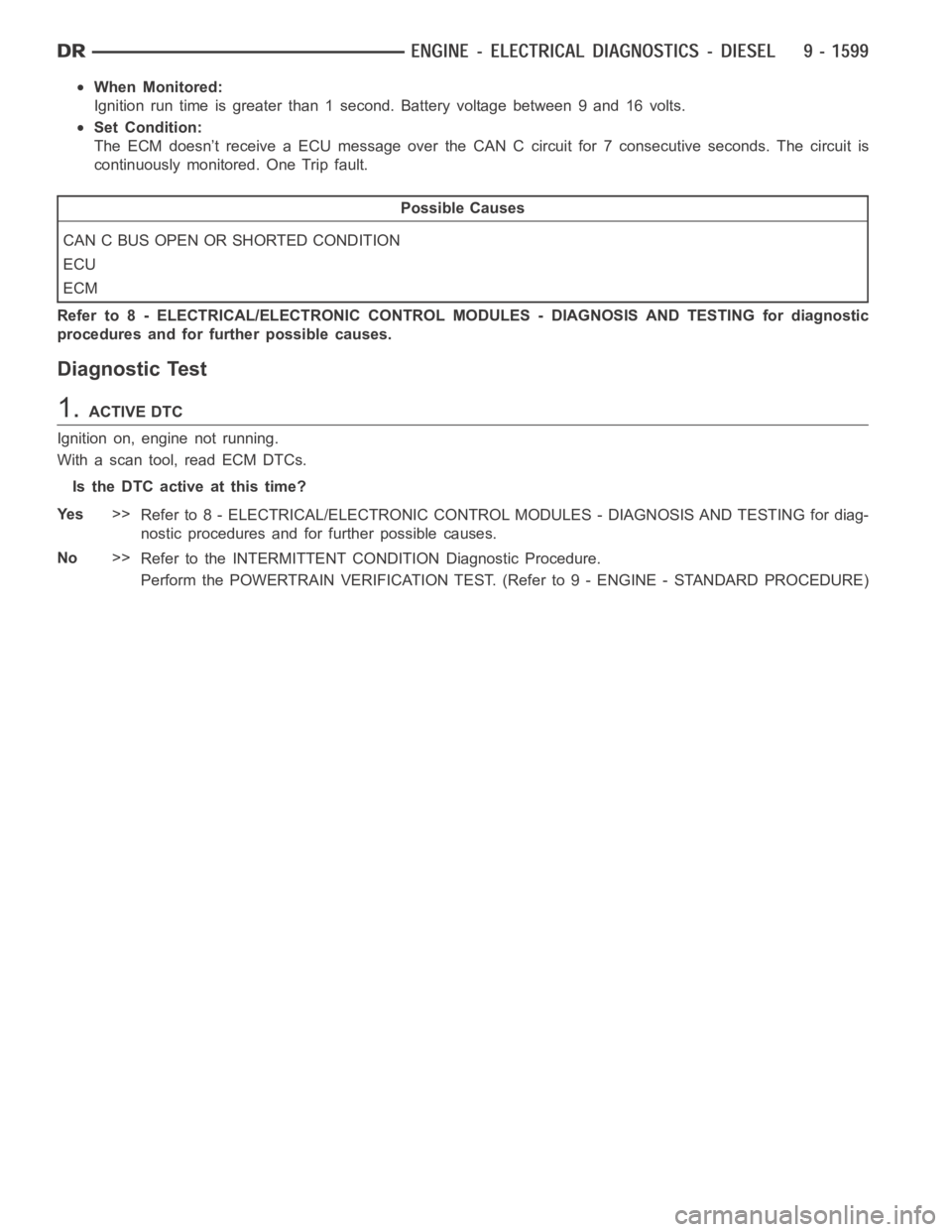
When Monitored:
Ignition run time is greater than 1 second. Battery voltage between 9 and 16volts.
Set Condition:
The ECM doesn’t receive a ECU message over the CAN C circuit for 7 consecutive seconds. The circuit is
continuously monitored. One Trip fault.
Possible Causes
CAN C BUS OPEN OR SHORTED CONDITION
ECU
ECM
Refer to 8 - ELECTRICAL/ELECTRONIC CONTROL MODULES - DIAGNOSIS AND TESTING for diagnostic
procedures and for further possible causes.
Diagnostic Test
1.ACTIVE DTC
Ignition on, engine not running.
With a scan tool, read ECM DTCs.
Is the DTC active at this time?
Ye s>>
Refer to 8 - ELECTRICAL/ELECTRONIC CONTROL MODULES - DIAGNOSIS AND TESTING for diag-
nostic procedures and for further possible causes.
No>>
Refer to the INTERMITTENT CONDITION Diagnostic Procedure.
Perform the POWERTRAIN VERIFICATION TEST. (Refer to 9 - ENGINE - STANDARD PROCEDURE)
Page 911 of 5267

page page
ENGINE - ELECTRICAL DIAGNOSTICS - SRT-10
DIAGNOSIS AND TESTING
PRE-DIAGNOSTIC TROUBLESHOOTING
PROCEDURE............................. 1606
INTERMITTENT CONDITION ............... 1607
P0031-O2 SENSOR 1/1 HEATER CIRCUIT
LOW..................................... 1608
P0032-O2 SENSOR 1/1 HEATER CIRCUIT
HIGH.................................... 1612
P0051-O2 SENSOR 2/1 HEATER CIRCUIT
LOW..................................... 1616
P0052-O2 SENSOR 2/1 HEATER CIRCUIT
HIGH.................................... 1620
P0071-AMBIENT/BATTERY TEMP SENSOR
PERFORMANCE.......................... 1624
P0107-MAP SENSOR VOLTAGE TOO LOW . 1629
P0108–MAP SENSOR VOLTAGE TOO HIGH . 1634
P0111-INTAKE AIR TEMP PERFORMANCE . . 1639
P0112-INTAKE AIR TEMP SENSOR
VOLTAGE TOO LOW...................... 1643
P0113-INTAKE AIR TEMPERATURE
SENSOR CIRCUIT HIGH.................. 1647
P0117-ENGINE COOLANT TEMPERATURE
SENSOR CIRCUIT LOW................... 1651
P0118-ENGINE COOLANT TEMP SENSOR
VOLTAGE TOO HIGH...................... 1655
P0121-TP SENSOR VOLTAGE DOES NOT
AGREE WITH MAP........................ 1659
P0122-THROTTLE POSITION SENSOR #1
VOLTAGE TOO LOW...................... 1667
P0123-THROTTLE POSITION SENSOR #1
VOLTAGE TOO HIGH...................... 1672
P0125-INSUFFICIENT COOLANT TEMP FOR
CLOSED-LOOP FUEL CONTROL........... 1677
P0131-O2 SENSOR 1/1 CIRCUIT VOLTAGE
TOO LOW................................ 1680
P0132-O2 SENSOR 1/1 CIRCUIT VOLTAGE
TOO HIGH............................... 1683
P0133-O2 SENSOR 1/1 SLOW RESPONSE . 1688
P0135-O2 SENSOR 1/1 HEATER
PERFORMANCE.......................... 1691
P0136-O2 SENSOR 1/2 HEATER CIRCUIT
MALFUNCTION........................... 1694
P0137-O2 SENSOR 1/2 CIRCUIT LOW ..... 1697
P0138-O2 SENSOR 1/2 CIRCUIT HIGH ..... 1701
P0139-O2 SENSOR 1/2 SLOW RESPONSE . 1706
P0141-O2 SENSOR 1/2 HEATER
PERFORMANCE.......................... 1709
P0151-O2 SENSOR 2/1 CIRCUIT LOW ..... 1713
P0152-O2 SENSOR 2/1 CIRCUIT HIGH ..... 1716
P0153-O2 SENSOR 2/1 SLOW RESPONSE . 1721P0155-O2 SENSOR 2/1 HEATER
PERFORMANCE.......................... 1724
P0157-O2 SENSOR 2/2 CIRCUIT VOLTAGE
TOO LOW................................ 1728
P0158-O2 SENSOR 2/2 CIRCUIT VOLTAGE
TOO HIGH............................... 1732
P0159-O2 SENSOR 2/2 SLOW RESPONSE . 1737
P0161-O2 SENSOR 2/2 HEATER
PERFORMANCE.......................... 1740
P0171-FUEL SYSTEM 1/1 LEAN ........... 1744
P0172-FUEL SYSTEM 1/1 RICH ............ 1751
P0174-FUEL SYSTEM 2/1 LEAN ........... 1757
P0175-FUEL SYSTEM 2/1 RICH ............ 1764
P0197-ENGINE OIL TEMPERATURE
SENSOR VOLTAGE TOO LOW............. 1770
P0198-ENGINE OIL TEMPERATURE
SENSOR VOLTAGE TOO HIGH............ 1773
P0201-FUEL INJECTOR 1 CIRCUIT ........ 1777
P0202-FUEL INJECTOR 2 CIRCUIT ........ 1781
P0203-FUEL INJECTOR 3 CIRCUIT ........ 1785
P0204-FUEL INJECTOR 4 CIRCUIT ........ 1789
P0205-FUEL INJECTOR 5 CIRCUIT ........ 1793
P0206-FUEL INJECTOR 6 CIRCUIT ........ 1797
P0207-FUEL INJECTOR 7 CIRCUIT ........ 1801
P0208-FUEL INJECTOR 8 CIRCUIT ........ 1805
P0209-FUEL INJECTOR 9 CIRCUIT ........ 1809
P0210-FUEL INJECTOR 10 CIRCUIT....... 1813
P0300-MULTIPLE CYLINDER MISFIRE ..... 1817
P0301-CYLINDER #1 MISFIRE ............. 1823
P0302-CYLINDER #2 MISFIRE ............. 1832
P0303-CYLINDER #3 MISFIRE ............. 1841
P0304-CYLINDER #4 MISFIRE ............. 1850
P0305-CYLINDER #5 MISFIRE ............. 1859
P0306-CYLINDER #6 MISFIRE ............. 1868
P0307-CYLINDER #7 MISFIRE ............. 1877
P0308-CYLINDER #8 MISFIRE ............. 1886
P0309-CYLINDER #9 MISFIRE ............. 1895
P0310-CYLINDER #10 MISFIRE ............ 1904
P0320–NO CANK REFERENCE SIGNAL AT
PCM..................................... 1913
P0325-KNOCK SENSOR 1 CIRCUIT ........ 1921
P0330-KNOCK SENSOR 2 CIRCUIT ........ 1925
P0340-CAMSHAFT POSITION SENSOR
CIRCUIT................................. 1929
P0352-IGNITION COIL #2 PRIMARY
CIRCUIT................................. 1936
P0353-IGNITION COIL #3 PRIMARY
CIRCUIT................................. 1940
P0354-IGNITION COIL #4 PRIMARY
CIRCUIT................................. 1944